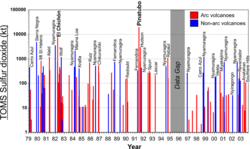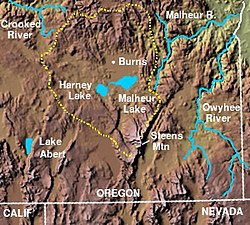
This timeline of volcanism on Earth includes a list of major volcanic eruptions of approximately at least magnitude 6 on the Volcanic explosivity index (VEI) or equivalent sulfur dioxide emission during the Quaternary period (from 2.58 Mya to the present). Other volcanic eruptions are also listed.
Contents
- Large Quaternary eruptions
- 1000–2000 AD
- Overview of Common Era
- Earlier Quaternary eruptions
- Large Neogene eruptions
- Pliocene eruptions
- Miocene eruptions
- Volcanism before the Neogene
- Notes
- Volcanic explosivity index (VEI)
- Volcanic dimming
- Map gallery
- See also
- References
- Further reading
- External links
Some eruptions cooled the global climate—inducing a volcanic winter—depending on the amount of sulfur dioxide emitted and the magnitude of the eruption. [1] [2] Before the present Holocene epoch, the criteria are less strict because of scarce data availability, partly since later eruptions have destroyed the evidence. Only some eruptions before the Neogene period (from 23 Mya to 2.58 Mya) are listed. Known large eruptions after the Paleogene period (from 66 Mya to 23 Mya) are listed, especially those relating to the Yellowstone hotspot, Santorini caldera, and the Taupō Volcanic Zone.
Active volcanoes such as Stromboli, Mount Etna and Kīlauea do not appear on this list, but some back-arc basin volcanoes that generated calderas do appear. Some dangerous volcanoes in "populated areas" appear many times: Santorini six times, and Yellowstone hotspot 21 times. The Bismarck volcanic arc, New Britain, and the Taupō Volcanic Zone, New Zealand, appear often too.
In addition to the events listed below, there are many examples of eruptions in the Holocene on the Kamchatka Peninsula, [3] which are described in a supplemental table by Peter Ward. [4]





















